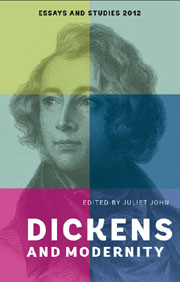Book contents
- Frontmatter
- Contents
- LIST OF ILLUSTRATIONS
- ACKNOWLEDGEMENTS
- NOTES ON THE CONTRIBUTORS
- INTRODUCTION
- 1 THE DICKENS TAPE: AFFECT AND SOUND REPRODUCTION IN THE CHIMES
- 2 DICKENS, SEXUALITY AND THE BODY; OR, CLOCK LOVING: MASTER HUMPHREY'S QUEER OBJECTS OF DESIRE
- 3 TEXTS, PARATEXTS AND ‘E-TEXTS’: THE POETICS OF COMMUNICATION IN DICKENS'S JOURNALISM
- 4 CORPUS STYLISTICS – DICKENS, TEXT-DRIVENNESS AND THE FICTIONAL WORLD
- 5 THINGS, WORDS AND THE MEANINGS OF ART
- 6 DICKENS AND THE CIRCUS OF MODERNITY
- 7 THE OLIVER! PHENOMENON; OR, ‘PLEASE, SIR, WE WANT MORE AND MORE!’
- 8 ‘WOW! SHE'S A LESBIAN. GOT TO BE!’: RE-READING/RE-VIEWING DICKENS AND NEO-VICTORIANISM ON THE BBC
- 9 OUT OF PLACE: DAVID COPPERFIELD'S IRRESOLVABLE GEOGRAPHIES
- 10 AFTERWORD: THE 2012 BICENTENARY
- Index
1 - THE DICKENS TAPE: AFFECT AND SOUND REPRODUCTION IN THE CHIMES
Published online by Cambridge University Press: 05 February 2013
- Frontmatter
- Contents
- LIST OF ILLUSTRATIONS
- ACKNOWLEDGEMENTS
- NOTES ON THE CONTRIBUTORS
- INTRODUCTION
- 1 THE DICKENS TAPE: AFFECT AND SOUND REPRODUCTION IN THE CHIMES
- 2 DICKENS, SEXUALITY AND THE BODY; OR, CLOCK LOVING: MASTER HUMPHREY'S QUEER OBJECTS OF DESIRE
- 3 TEXTS, PARATEXTS AND ‘E-TEXTS’: THE POETICS OF COMMUNICATION IN DICKENS'S JOURNALISM
- 4 CORPUS STYLISTICS – DICKENS, TEXT-DRIVENNESS AND THE FICTIONAL WORLD
- 5 THINGS, WORDS AND THE MEANINGS OF ART
- 6 DICKENS AND THE CIRCUS OF MODERNITY
- 7 THE OLIVER! PHENOMENON; OR, ‘PLEASE, SIR, WE WANT MORE AND MORE!’
- 8 ‘WOW! SHE'S A LESBIAN. GOT TO BE!’: RE-READING/RE-VIEWING DICKENS AND NEO-VICTORIANISM ON THE BBC
- 9 OUT OF PLACE: DAVID COPPERFIELD'S IRRESOLVABLE GEOGRAPHIES
- 10 AFTERWORD: THE 2012 BICENTENARY
- Index
Summary
What would you give for a recording of Dickens reading? Who would not treasure a scrap of the Inimitable's voice? Dickens himself wanted people to hear him. He revelled in public readings where his voice brought to life Micawber and Pickwick, the death of Little Nell and the hanging of Sikes. Recordings of other nineteenth-century voices exist – Tennyson, Browning and Whitman, among writers – and the tenuous thread of their words reaches toward us as from another world. The crackle of static is like the noise of time itself. Dickens, who was interested in sound technology, would have been one of the first in line to bury his head in a speaking trumpet and bellow, ‘I never will desert Mr Micawber’. But, unless Charles Babbage is right and sound waves leave permanent impressions on the air, we shall never hear the departed voice of one of the pioneers of public readings. Dickens died seven years before the invention of the phonograph, and the sound of his speech has been lost for ever.
Visual recordings of Dickens abound. The novelist lived to see the development of several different forms of photography, and there are memorable drawings, paintings and photographs of the author. In fact, no writer has ever dwelled in a world devoid of visual representation. But until the late nineteenth century, sound was rarely thought of as a suitable medium for recording.
- Type
- Chapter
- Information
- Dickens and Modernity , pp. 19 - 40Publisher: Boydell & BrewerPrint publication year: 2012

